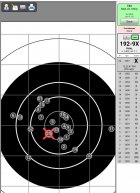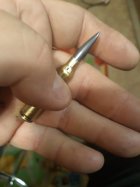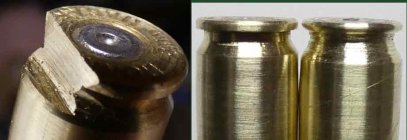You're saying that you believe that a direct measurement of internal volume is astrology, but you think you should weight sort your brass instead? Thats totally backwards thinking if you're looking for the most accurate measurement of volume. Brass weight that is the same identical external dimensions -could- also vary in brass density, which makes measuring water volume via weight the more precise of the two measurements.
Water volume measurement in my experience is also extremely consistent and repeatable and the margin of error on the measurement definitely does not exceed the difference between cases that you can measure.
Seriously???
You actually believe that 2 cases from the same manufacturing lot that weigh the same have a volumetrically different amount of brass that you can detect by filling it with water?
Any chance there is a bubble inside the case somewhere that you cant see?
Any chance the meniscus from one case to the next may be the cause of the weight discrepancy?
Any chance you got a little inconsistent wetness or drop of water on the outside of the case?
Any chance that the cases you are measuring also have different outside dimensions as well but you lack the ability to measure that due to the complex geometry?
Hence the reason I said fire form them twice.
I have no doubt you will find different weights when filling your cases with water, but I have no confidence whatsoever that case to case brass density variability can be determined by something as fundamentally crude as the water fill method.
If you use this method to sort brass, you are not sorting brass by volume. You are sorting brass according to the error in the method you are using to sort the brass.
Across the world, metals are sold by weight for a reason. You can calculate the weight of a piece of brass by multiplying length x width x height x conversion factor of 0.3034693 (for brass) to determine the weight in pounds. The conversion factor may change slightly based upon the metallurgical subtleties and alloy composition but within a lot of brass or even within a brand of brass, the error you describe is so minute that it would require advanced scientific equipment to detect.
I'll exaggerate the point for clarity... Perhaps think of your rifle chamber as the volume you are filling instead of the case. You are filling that volume with a variety of components that displace space within the chamber. If you melted the brass into a ball and put it inside the case, it will regardless of shape displace a specific and consistent amount of space by weight.
Even if somehow the water method was accurate, and could reliably determine the inside volume of two cases that weigh the same... it remains irrelevant, because under pressure, the case will expand to fit the chamber walls and then the internal volume of two identical weighing cases will be the same.
Even if there were some microscopic volumetric difference.... I'm sorry, but water is not the way to find it and the error is far too slight to bother considering. Best to focus energy elsewhere.
I'm going to take this even one step further for you... I have loaded rounds that produce single digit ES with 223 using 80, 88 and 90 grain bullets and once fired military brass from lord knows how many lots that I bought, processed, annealed and sorted only by weight to within 0.1 grains. Once they have been fired in the rifle twice, they are as good as anything at less than 1/10th of the cost. If I can do this on a regular basis with random cases from the military, its the process I described above... not water.















